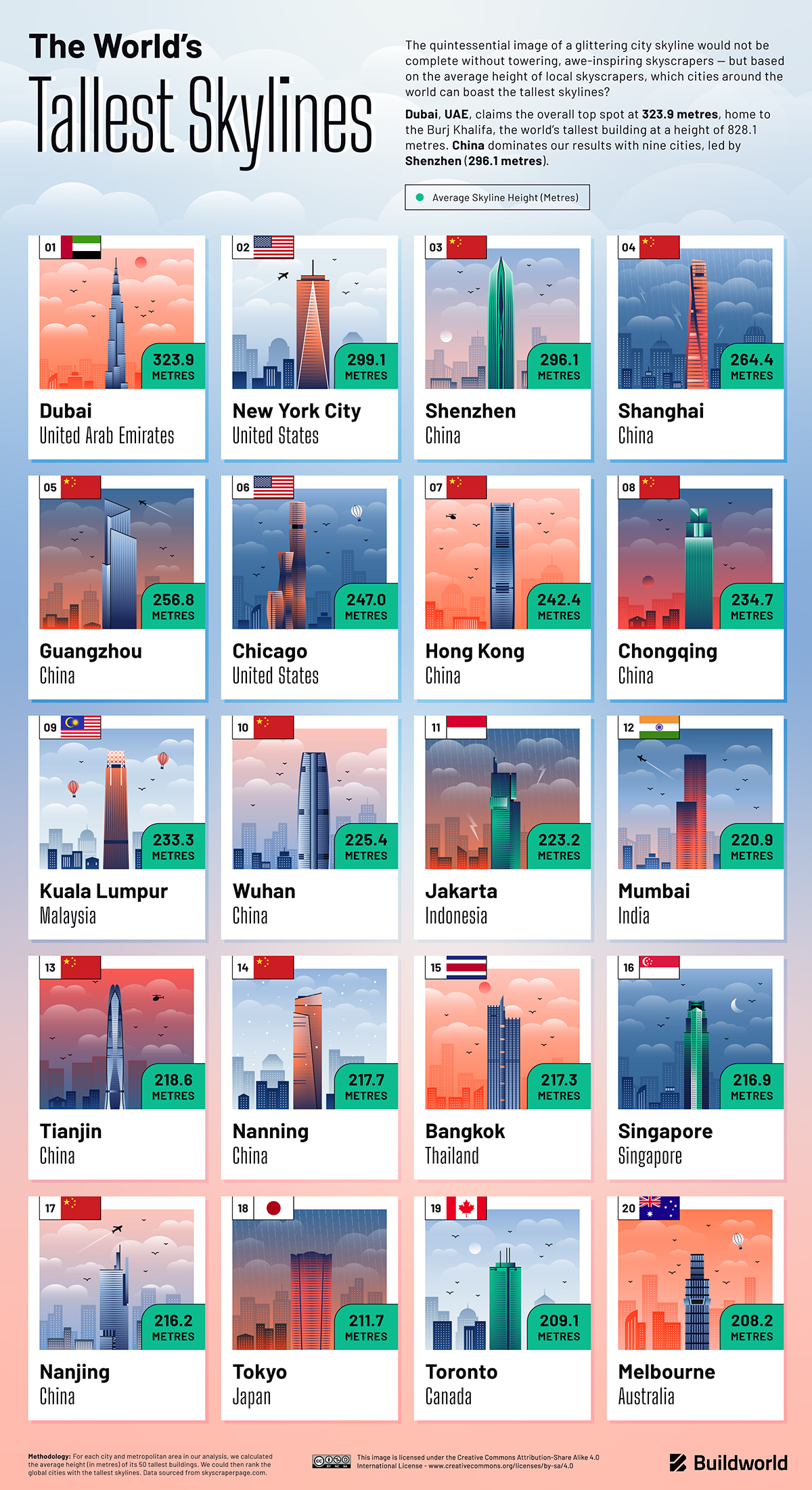
Skyscrapers can be traced back to the late 19th century when Chicago, often dubbed the "birthplace of skyscrapers," saw the construction of the Home Insurance Building in 1885. Standing at a mere ten stories, it may seem modest by today's standards, but it revolutionised construction techniques with its steel frame, ushering in the era of vertical architecture.
Skyscrapers were not just individual buildings but were often part of a larger, longer-term vision for vertical cities. More now than ever, in densely populated urban areas, they allow for the efficient use of limited space, accommodating thousands of people, offices, and amenities within a small footprint.
But beyond functionality, skyscrapers also became canvases for architectural expression. Architects like Frank Lloyd Wright, Ludwig Mies van der Rohe, and Frank Gehry pushed the envelope with their artistic visions. The Guggenheim Museum in Bilbao, Spain, designed by Gehry, is a masterpiece that defies convention with its titanium curves. The Burj Khalifa in Dubai, designed by Adrian Smith, symbolises modern elegance and innovation. These iconic designs helped shape the architecture landscape and continue to inspire, drawing in visitors from around the world.
Yet however beautiful or brilliant, skyscraper-filled cities are a divisive aesthetic, with some arguing that city skylines that were once clear are now congested with tall buildings. In contrast, others can appreciate the art and the underlying economic development that skyscrapers usually represent.
But which cities boast the tallest skylines worldwide, and how have they changed over the years?
What We Did
Buildworld analysed a database of more than 109,000 skyscrapers and high-rise buildings in cities and metropolitan areas around the world. We collected the height in metres and the completion date and/or destruction of each building, all sourced from skyscraperpage.com.
To rank the cities with the tallest skylines and the city in each country with the tallest skyline, we averaged the height (in metres) of its 50 tallest buildings.
We also calculated the average height (in metres) of all skyscrapers built and/or destroyed per year and decade between 1900 and May 2023 for all cities in our dataset and for London, New York, Dubai, Toronto, Hong Kong and Melbourne.
Key Findings
- Dubai, UAE, has the tallest skyline in the world, with an average height of 323.9 metres
- The world's second-tallest skyline belongs to New York, U.S (299.1 metres)
- China dominates the results with nine cities amongst the top 20 tallest skylines in the world, led by Shenzhen (296.1 metres)
- Completed in 1710, St Paul's Cathedral was the tallest building in London, UK at a height of 111.3 metres, until the Millbank Tower was built in 1963 (119.0 metres) which was quickly surpassed by the BT Tower (188.4 metres) in 1964
- In 1900, the average height of New York's skyscrapers was 60.7 metres, the average height today is 83.4 metres
- Hong Kong's skyline has nearly doubled in the last century, from 57.4 metres in 1935 to 116.8 metres in 2023
Dubai is Home to The World's Tallest Skylines
Now, not every high-rise warrants being called a skyscraper. The exact definition varies, but most architects agree that 150 metres (about 492 feet) is the minimum height to qualify. Label or no label, building heights around the world continue to soar. But based on the average height of local skyscrapers, which cities can claim the tallest skylines?

Click here to see the image in full size
It might not surprise that Dubai, UAE, is the ultimate city in the clouds, where the average height of a building is 323.9 metres. The city's skyline is adorned with architectural wonders like the twisting Cayan Tower, the elegant Princess Tower, and the Burj Al Arab, which is shaped like a billowing sail. The jewel in the crown, though, is the Burj Khalifa - the world's tallest building, standing at an impressive 828.1 metres, the world's tallest structure (previously held by the KVLY-TV mast in Blanchard, North Dakota) and the tallest free-standing structure (previously held by Toronto's CN Tower).
China dominates the results, with nine cities making the top 20, led by Shenzhen (296.1 metres). Though Hong Kong boasts around 200 more skyscrapers, Shenzhen's tallest building is more impressive. Standing at 599.1 metres, Ping An International Finance Centre is the second-tallest building in the country and the fifth-tallest skyscraper on Earth.
Interestingly, the Council on Tall Buildings and Urban Habitat (CTBUH) reported that as of September 2020, there were 81 unfinished skyscrapers in China where construction had been suspended, among which 66 are expected never to be completed. This could have contributed to its ban on "supertall skyscrapers", which was imposed a year later.
The Tallest Skyline in Every Country
Today, every country showcases tall buildings that define its modern skyline, from the iconic Burj Khalifa in the United Arab Emirates to the futuristic Shanghai Tower in China and the towering One World Trade Center in the United States.
These staggering structures stand as a testament to creativity and engineering prowess and serve as beacons of economic growth and urban development. However, the symbolism of skyscrapers is highly debated. Some might say that these "towers of power" reinforce capitalism and ruin views of the city.
Whether aesthetically pleasing or not, many countries take pride in their unique architectural marvels. But which is the tallest skyline in each?

Click here to see the image in full size
Our map highlights which cities are home to the tallest skylines in every country around the world. Naturally, Dubai, New York and Shenzhen all make the cut. As does Kuala Lumpur in Malaysia, where the average height of a building is 233.3 metres. The city was once the home of the world's tallest building thanks to The Petronas Towers, a pair of 88-storey supertall skyscrapers. They were officially the tallest buildings in the world until 2004 and remained the tallest buildings in Malaysia until 2019 when they were surpassed by The Exchange 106.
Toronto in Canada (209.1 metres), Melbourne in Australia (208.2 metres) and London in the UK (171.6 metres) all feature. Interestingly, so does Athens in Greece (66.4 metres). According to World Atlas, the city has a height restriction in place where buildings legally cannot surpass twelve floors tall.
The Sky's The Limit
From humble beginnings in the late 19th century to the soaring structures of today, the evolution of skyscrapers has been a testament to human ingenuity and ambition. Love or loathe them, these towering structures have reshaped skylines, redefined urban landscapes, and captured our imaginations.
As cities strive for sustainability, architects have embraced green building practices, incorporating solar panels, rainwater harvesting, and green roofs into their designs. The Bullitt Center in Seattle and the Shanghai Tower are prime examples of eco-friendly skyscrapers leading the way towards a greener future.
The exploration of new heights, sustainable solutions, and innovative design continues, and the impact of skyscrapers on architecture will only intensify. Perhaps in the not-so-distant future, we will witness even more breathtaking feats of engineering, art, and urban planning that will shape the cities of tomorrow.
Innovation does not have to stop with the skyscrapers; get creative with your home with the help of Buildworld. Combine a vast number of styles of external and internal doors from a wide variety of brands to create the perfect look for your space. From coloured doors to flush doors to even French doors, we got it all!
Methodology & Sources
Our analysis considers the height in metres and the completion date and/or destruction of more than 109,000 skyscrapers and high-rise buildings in cities and metropolitan areas worldwide. The details on skyscrapers and high-rise buildings were sourced from skyscraperpage.com.
For each city, we averaged the height (in metres) of its 50 tallest buildings to rank the cities with the tallest skylines and the city in each country with the tallest skyline.
We also calculated the average height (in metres) of all skyscrapers built and/or destroyed per year and decade between 1900 and May 2023 for all cities in our dataset and for London, New York, Dubai, Toronto, Hong Kong and Melbourne.
Cities and other locations with fewer than 20 skyscrapers or high-rise buildings were excluded from our final analysis. In cases where a notable tall building's height was recorded differently than official sources, we opted for the highest measurement recorded by either skyscraperpage.com or another official source to consider a building's highest point, which includes spires or antennas.
The data for our research is correct as of August 2023.
Related Articles
Category
Study & ResearchPosted On
3rd September 2021



